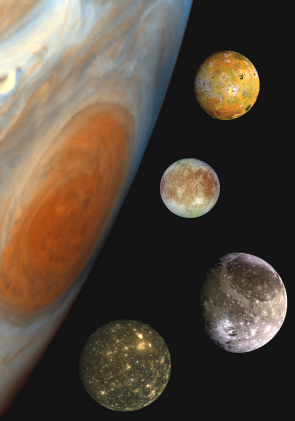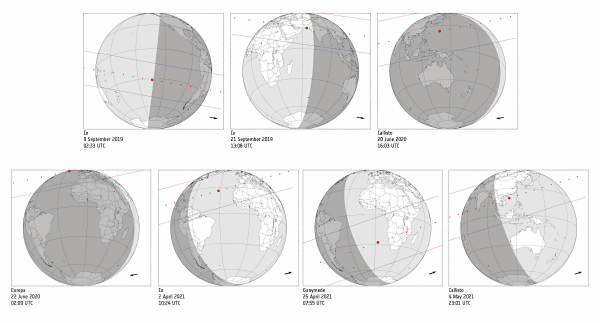Astronomers spy Europa blocking distant star – thanks to Gaia
25 July 2019
On 31 March 2017, Jupiter's moon Europa passed in front of a background star – a rare event that was captured for the first time by ground-based telescopes thanks to data provided by ESA's Gaia spacecraft. |
| Jupiter's largest moons. Credit: NASA/JPL/DLR |
Previously, observatories had only managed to watch two of Jupiter's other moons – Io and Ganymede – during such an event.
Gaia has been operating in space since late 2013. The mission aims to produce a three-dimensional map of our Galaxy, and characterise the myriad stars that call the Milky Way home. It has been immensely successful so far, revealing the locations and motions of over one billion stars.
Knowing the precise locations of the stars we see in the sky allows scientists to predict when various bodies in the Solar System will appear to pass in front of a background star from a given vantage point: an event known as a stellar occultation.
Gaia is no stranger to such events – the spacecraft helped astronomers make unique observations of Neptune's moon Triton as it passed in front of a distant star in 2017, revealing more about the moon's atmosphere and properties.
Occultations are hugely valuable; they enable measurements of the characteristics of the foreground body (size, shape, position, and more), and can reveal structures like rings, jets, and atmospheres. Such measurements can be made from the ground – something that Bruno Morgado of the Brazilian National Observatory and LIneA, Brazil, and colleagues took advantage of to explore Jupiter's moon Europa.
"We used data from Gaia's first data release to forecast that, from our viewpoint in South America, Europa would pass in front of a bright background star in March 2017 – and to predict the best location from which to observe this occultation," said Bruno, lead researcher of a new paper reporting the findings from the 2017 occultation. Gaia's first data release was provided in September 2016.
"This gave us a wonderful opportunity to explore Europa, as the technique offers an accuracy comparable to that of images obtained by space probes."
The Gaia data showed that the event would be visible from a thick band slicing from north-west to south-east across South America. Three observatories located in Brazil and Chile were able to capture data – a total of eight sites attempted, but many experienced poor weather conditions.
In-keeping with previous measurements, the observations refined Europa's radius to 1561.2 km, precisely determined Europa's position in space and in relation to its host planet, Jupiter, and characterised the moon's shape. Rather than being exactly spherical, Europa is known to be an ellipsoid. The observations show the moon to measure 1562 km when measured across in one direction (the so-called apparent 'semi-major' axis), and 1560.4 km when measured across the other (the apparent 'semi-minor' axis).
"It's likely that we'll be able to observe far more occultations like this by Jupiter's moons in 2019 and 2020," adds Bruno. "Jupiter is passing through a patch of sky that has the galactic centre in the background, making it drastically more likely that its moons will pass in front of bright background stars. This would really help us to pin down their three-dimensional shapes and positions – not only for Jupiter's four largest moons, but for smaller, more irregularly-shaped ones, too."
 |
| Upcoming stellar occultations by Jupiter's four largest moons. Credit: ESA/Gaia/DPAC; Bruno Morgado (Brazilian National Observatory/LIneA, Brazil) et al. (2019) |
Using Gaia's second data release, provided in April 2018, the scientists predict the dates of further occultations of bright stars by Europa, Io, Ganymede and Callisto in coming years, and list a total of 10 events through 2019 and 2021. Future events comprise stellar occultations by Europa (22 June 2020), Callisto (20 June 2020, 4 May 2021), Io (9 and 21 September 2019, 2 April 2021), and Ganymede (25 April 2021).
Three have already taken place in 2019, two of which – stellar occultations by Europa (4 June) and Callisto (5 June) – were also observed by the researchers, and for which the data are still under analysis.
The upcoming occultations will be observable even with amateur telescopes as small as 20 cm from various regions around the world. The favourable position of Jupiter, with the galactic plane in the background, will only occur again in 2031.
"Stellar occultation studies allow us to learn about moons in the Solar System from afar, and are also relevant for future missions that will visit these worlds," says Timo Prusti, ESA Gaia Project Scientist. "As this result shows, Gaia is a hugely versatile mission: it not only advances our knowledge of stars, but also of the Solar System more widely."
| JUICE's Jovian odyssey. Click here for details and large versions of the video. Credit: ESA |
An accurate knowledge of Europa's orbit will help to prepare space missions targeting the Jovian system such as ESA's JUpiter ICy moons Explorer (JUICE) and NASA's Europa Clipper, both of which are scheduled for launch in the next decade.
"These kinds of observations are hugely exciting," says Olivier Witasse, ESA's JUICE Project Scientist. "JUICE will reach Jupiter in 2029; having the best possible knowledge of the positions of the system's moons will help us to prepare for the mission navigation and future data analysis, and plan all of the science we intend to do.
"This science depends upon us knowing things such as accurate moon trajectories and understanding how close a spacecraft will come to a given body, so the better our knowledge, the better this planning – and the subsequent data analysis – will be."
Notes for editors
The study was presented in the paper "First stellar occultation by the Galilean moon Europa and upcoming events between 2019 and 2021" by B. Morgado et al. (2019), in Astronomy & Astrophysics.
Details of past and future stellar occultation observing campaigns for Jupiter's moons and other Solar System objects will be listed here: http://lesia.obspm.fr/lucky-star/campaigns.php
Gaia was launched in 2013 to create the most precise three-dimensional map of more than one billion stars in the Milky Way. The mission has released two lots of data thus far: Gaia Data Release 1 in 2016 and Gaia Data Release 2 in 2018. More releases will follow in the coming years.
JUICE is the first large-class mission in ESA's Cosmic Vision 2015–2025 programme. It is planned for launch in 2022, and will complete a unique tour of Jupiter and its large ocean-bearing moons Europa, Ganymede and Callisto after it arrives in 2029.
For more information, please contact:
Bruno Morgado
Observatório Nacional/MCTIC, Brazil; LIneA, Brazil
Email: brunomorgado![]() on.br
on.br
Timo Prusti
ESA Gaia Project Scientist
Email: tprusti![]() cosmos.esa.int
cosmos.esa.int
Olivier Witasse
ESA JUICE Project Scientist
Email: Olivier.Witasse![]() esa.int
esa.int



